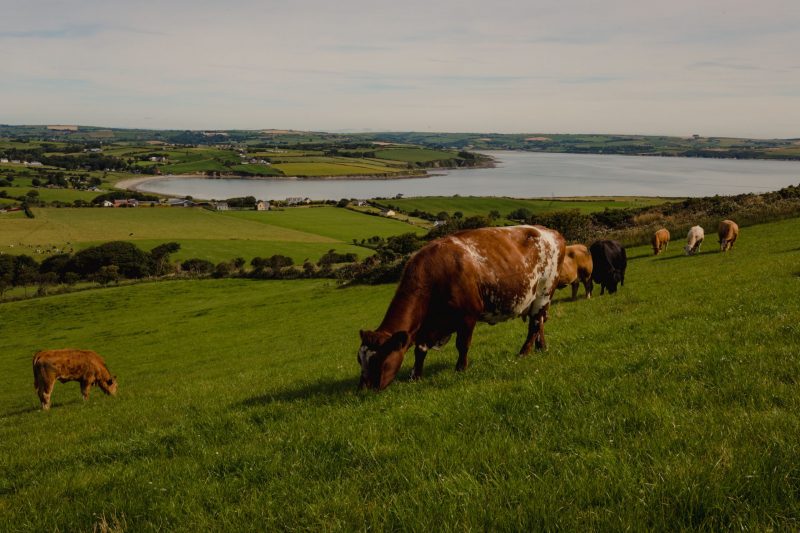Irish Grass Fed Beef PGI
PGI ‘Irish Grass Fed Beef’ cattle must be born and raised on grass, finished, slaughtered, chilled and quartered on the island of Ireland. Throughout their lifetime, cattle must spend an average of 220 days per year on grazing pasture. Their diet must be at least 90% grass. This is primarily grazed grass, with winter feeding of wilted grass.

Steers and heifers up to 36 months with conformation better than O- and a fat score between 2+ and 4+ are eligible. Beef cows up to 120 months with conformation better than O+ and a fat score between 2+ and 5 also qualify.
Meat maturation must be a minimum of 48 hours, or 72 hours for hindquarter cuts. Each animal must be assessed to ensure it meets the grass-fed standard.
PGI Irish grass-fed beef assessments are made by a Bord Bia farm and processor scheme that meet international best practice standards and are rigorously and independently audited by the Sustainable Beef and Lamb Assurance Scheme (SBLAS).
The best beef around
Consumer taste tests in European and global markets by Bord Bia found ‘Irish Grass Fed Beef ranked highly among consumers on taste intensity, texture and balance of fat in the meat. Expert tasting panels consistently award more medals to striploins, rib eyes and fillets from ‘Irish Grass Fed Beef’ than any other competing country. (World Steak Challenge 2022, 2023)
Many leading restaurants around the world feature ‘Irish Grass Fed Beef.’ In fact, the Chefs’ Irish Beef Club (CIBC) has nine chapters and 100 chefs worldwide who select ‘Irish Grass Fed Beef’ as their beef of choice.
Recent studies by Teagasc, the Agriculture and Food Development Authority of Ireland, confirmed that ‘Irish Grass Fed Beef’ has a higher ratio of omega-3 fatty acids, minerals and vitamins than non or low-grass fed beef. These include higher concentrations of: calcium, manganese, iron, zinc, selenium, sodium, magnesium, potassium, phosphorus and vitamin E.

Tradition and science
Ireland’s unique dependence on grass-based agriculture, derived from its grass growing potential has been evident for centuries. A mild climate and frequent rain allow beef herds to graze on lush pastures up to 300 days a year.
Cattle rearing has been integral to the Irish economy and rural communities. Ireland’s family farms are small to medium sized. Typically, each farm has 50 livestock and 3,000 square metres of land per animal. This allows farmers to keep a regular eye on all livestock.
Irish cattle enjoy a high standard of welfare and low stress throughout their lives. When transported for processing, Irish cattle only travel short distances, usually less than two hours.
Farms and farming techniques are handed down from generation to generation. Traditional knowledge is boosted by cutting edge technology and science. Every animal in every beef herd is traceable online in real-time from birth to processing, manufacturing and packing.
Genomics has revolutionised the cattle breeding industry. As Ireland genotypes the national herd, the potential of animals can be determined earlier and more accurately. New, economically advantageous traits can be identified, leading to continuous improvement in eating quality, profitability and sustainability that strengthen the global reputation of ‘Irish Grass Fed Beef’.

A unique herd
The Irish beef herd differs from other beef systems. It results from crossing traditional breeds (e.g. Hereford, Angus and Shorthorn) with dairy breeds (with strong maternal traits) and Continental European beef breeds (e.g. Limousin, Charolais and Simmental).
This crossbred animal is hardy and optimally adapted to the climate and geography of Ireland. It also produces an excellent carcase confirmation, more even fat cover and better marbling.
Technical specification
All Irish grass fed beef PGI carcasses must be from one of the following categories:
- Steers and heifers aged up to 36 months. Conformation better than O-. Fat score between 2+ and 4+.
- Beef cows of up to 120 months. Conformation better than O+. Fat score between 2+ and 5.
The two categories must be separately batched, deboned, packed and labelled. High pH (> 5,8) carcases must be identified and excluded.
Carcasses must be assessed to ensure they have a pronounced cherry-red meat colour and a high degree of creaminess/yellowness of fat.
Fresh and frozen bone-in and boneless beef are eligible. This includes carcases, quarters, bone-in cuts, boneless primal cuts, minced beef of those cuts and retail packs.
PGI ‘Irish Grass Fed Beef’ can be labelled on minced beef and minced beef products containing 100% Irish Grass Fed Beef and a minimum of 90% visual lean beef.
Products that may be labelled ‘as derived’ from PGI ‘Irish Grass Fed Beef’ are: composite beef containing 100% Irish Grass Fed Beef and a minimum of 90% visual lean beef; premium offals (cheek, tail, thick-skirt and tongue) sourced from qualifying categories of ‘Irish Grass Fed Beef’ cattle.




